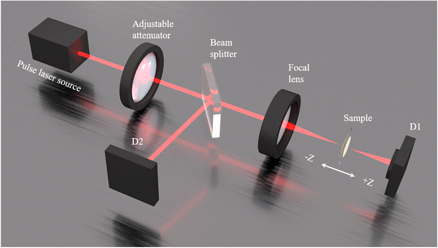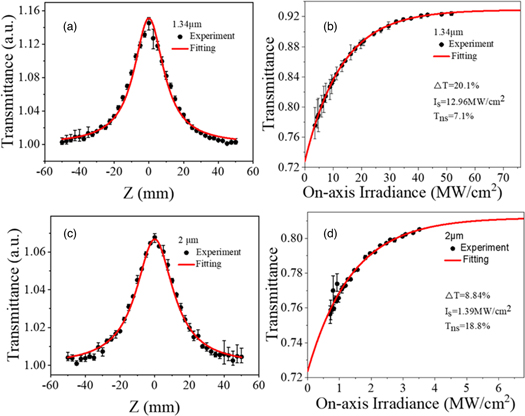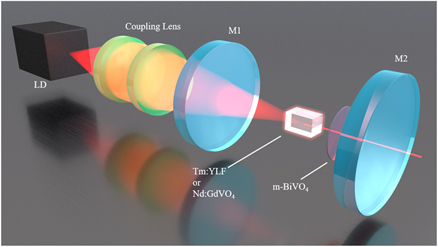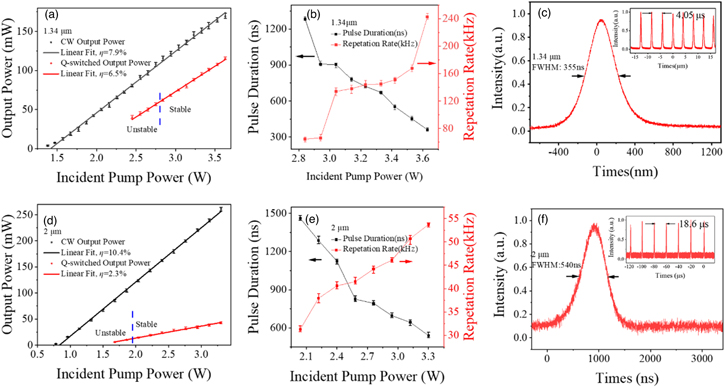Abstract
We synthesized monoclinic bismuth vanadate (m-BiVO4) nanoparticles via the sol-gel method. The modulation depths were 20.1% and 8.8% at 1.34 and 2 μm, respectively. Passively Q-switched bulk lasers with m-BiVO4 saturable absorber were demonstrated operating at 1.34 and 2 μm. At 1.34 μm, the shortest pulse duration was 355 ns with a pulse repetition frequency of 242.6 kHz, while in a Tm-doped bulk laser at ∼2 μm, the minimum pulse width was 540 ns with a pulse repetition rate of 53.7 kHz. Results showed that m-BiVO4 possessed good broadband optical nonlinearities and can be applied for the optical pulse generation.
Export citation and abstract BibTeX RIS
In recent decades, nanomaterials have aroused significant research enthusiasm due to their unique structures and extraordinary optical and optoelectrical properties. 1–4) These nanomaterials have great applications in (bio)sensors, 5) energy storage and conversion, 6,7) catalysis, 8) and photonics and optoelectronic integrated circuits, 9,10) owing to their atomic scale, mechanical stability, and eminent photoelectric properties. In particular, the optical modulators play an essential role in the optical interconnects, optical communications, optical signal processing and ultrafast pulse generation. Up to now, numerous optical modulators have been proposed to manipulate the intensity, phase, and repetition rate of light. 11–14) In comparison with the active control by the electronics or another light beam, passive saturable absorbers (SAs) offer a simple but efficient way for the optical pulse generation. Currently, a myriad of nonlinear optical materials including transition-metal oxide and transition-metal nanoparticles (NPs) have been used as the SA. 15–17) However, to obtain more efficient and stable optical pulses, it is still necessary to explore new SAs based on nanomaterials.
Vanadate crystal is considered as an excellent laser host such as GdVO4 and YVO4. 18,19) In addition, the pure bulk vanadate crystal has been widely used as the Raman gain medium, showing great optical nonlinearities. Another vanadate, bismuth vanadate is commonly used as the yellow pigment owing to its non-toxic features. Currently, monoclinic bismuth vanadate (m-BiVO4) possesses the stable physiochemical and thermal properties and is found to possess efficient photocatalytic activity. 20,21) Under the light irradiation, the photogenerated carriers can be transferred and can boost the photocatalysis effect owing to the layered structure. The nonlinear optical response of m-BiVO4 still must be investigated for various applications.
In this paper, m-BiVO4 NPs is applied as the SA in neodymium (Nd) and thulium (Tm) doped lasers. m-BiVO4 NPs were prepared by the sol-gel method. In addition, the nonlinear optical properties were studied by the open aperture (OA) Z-scan technology. The shortest Q-switching pulses of 355 and 540 ns were obtained at 1.34 and 2 μm, respectively. Results confirmed that the m-BiVO4 NPs have considerable optical nonlinearities for the light modulation in the broadband near-infrared region.
4 mmol of Bi(NO3)3·5H2O (AR) was put into 20 ml of HNO3 solution (69 wt%, 6 mol l−1) and stirred for 30 min. Then we dropped in NH₃·H₂O (30 wt%) to achieve pH = 8. After continuous stirring for 40 min, a transparent solution labelled as A can be obtained. We dissolved 4 mmol of NH4VO3 (AR) in 20 ml of boiling water and magnetically stirred the mixture for 30 min, afterward a uniform blue solution designated B was obtained. Solutions A and B were mixed together, ensuring a Bi:V ratio of 1:1, and the mixed solution was then put into a water bath with a constant temperature of 80 °C accompanied by continuous stirring until the mixed solution turned into a light blue sol. We then dried the blue sol in an oven at 100 °C until it became a dry gel. Afterward, we crushed the dry gel into uniform mixed powders with an agate mortar. Ultimately, we calcined the powder in a muffle furnace at 500 °C for 240 min. When the furnace temperature dropped to room temperature, the bright yellow m-BiVO4 powder was obtained. Subsequently, we dispersed 0.2 g of m-BiVO4 powder into 7 ml of ethanol and then subjected the mixed dispersion to 2 h of ultrasonic treatment in a water bath at a power of 100 W. Next, the suspension was centrifuged at 2000 rpm for 5 min to obtain ethanol supernatant. Then 0.3 ml of homogeneous ethanol supernatant of m-BiVO4 NPs was transferred to a BK7 substrate, and the sample was then placed in a N2 drying oven at 60 °C for 20 min to prepare the m-BiVO4 SA.
To characterize the microscopic structure of m-BiVO4 NPs, SEM and TEM were implemented. As shown in Figs. 1(a)–1(c), the particle size ranges from tens to hundreds of nanometers. Figure 1(d) shows the TEM morphology, the inset clearly demonstrating the lattice spacing of 0.292 nm, corresponding to the (040) crystal plane of m-BiVO4. The typical XRD pattern was shown in Fig. 1(e). The highest peak at 2θ = 29.02° can be assigned to the (121) crystal plane, while the peak at 2θ = 30.68° corresponds to the (040) crystal plane. According to the XRD pattern, the lattice constants of the m-BiVO4 were 5.198, 11.69 and 5.08 Å, respectively, and the included angles of the crystal axes were 90°, 90.43° and 90°, respectively, in agreement with the standard data (PDF# 14-0688). The UV–vis-IR absorption spectrum is shown in Fig. 1(f) within 250–2500 nm. In order to obtain the band gap, the Tauc plot method 22,23) was used for the direct bandgap semiconductors: 24)

where α is the absorption coefficient, hν represents the photon energy, B is a constant and Eg is the band gap energy. The inset of Fig. 1(f) clearly shows the relationship between (αhν) 2) and the incident photon energy hν. As shown in Fig. 1(f), the band gaps of m-BiVO4 NPs are 0.5, 2.19, 2.44 eV, respectively, which agree with the band gap energy previously reported. 25) The lowest band gap of 0.5 eV can be assigned to the oxygen vacancies and the band gap of 2.19 eV corresponds to the bismuth vacancies in m-BiVO4 NPs, 25) which were also in agreement with the density functional theory simulation.
Fig. 1. (Color online) Characterization of m-BiVO4 NPs: (a)–(c) SEM; (d) TEM; (e) XRD pattern; (f) UV–vis-NIR absorption spectrum, inset: Tauc plot.
Download figure:
Standard image High-resolution imageThe nonlinear absorption features of the m-BiVO4 NPs were measured by the open-aperture (OA) Z-scan technology. The experimental configuration is shown in Fig. 2. The excitation pulse width was 100 ns with a repetition rate of 3 kHz. The Z-dependent nonlinear normalized transmittance as a function of the relative position Z is shown in Figs. 3(a) and 3(c) under the on-axis irradiances of 10.8 MW cm−2 at 1.34 μm and 4 MW cm−2 at 2 μm, respectively. The nonlinear peak curves can be fitted with the Taylor expansion: 26)


here, T(Z) is the Z-dependent nonlinear normalized transmittance, Leff = [1–exp(–Lα)]/α is the effective length of the sample, L is the sample length, α is the linear absorption coefficient, I0 is the on-axis irradiance at focus, and Z0 = πω0 2/λ is the Rayleigh length at the wavelength λ with a beam waist of ω0. The effective nonlinear absorption coefficients βeff were −0.81 cm MW−1 at 1.34 μm and −0.76 cm MW−1 at 2 μm, respectively. In addition, the on-axis irradiance-dependent nonlinear transmission versus the incident excitation intensity was also measured, as shown in Figs. 3(b) and 3(d). The on-axis irradiance-dependent nonlinear transmission can be fitted with the following equation: 27)

As a consequence, the modulation depth ΔT, the saturation intensity Is and the non-saturated losses Tns can be obtained. As shown in Fig. 3(b) at 1.34 μm, the modulation depth is 20.1% with a saturation intensity of 12.96 MW cm−2 and a non-saturated loss of 7.1%. At 2 μm, the modulation depth was 8.84%, the saturation intensity was 1.39 MW cm−2 and the non-saturated loss was 18.8%.
Fig. 2. (Color online) Schematic setup for the OA Z-scan technique.
Download figure:
Standard image High-resolution imageFig. 3. (Color online) (a) Z-dependent and (b) on-axis irradiance-dependent nonlinear transmission at 1.34 μm; (c) Z-dependent and (d) on-axis irradiance-dependent nonlinear transmittances at 2 μm.
Download figure:
Standard image High-resolution imageSince m-BiVO4 NPs possessed a large modulation depth at 1.34 μm and relatively low saturation intensity at 2 μm as compared with other SAs in Table II, we worked to realize the passive Q-switching operation in bulk lasers with m-BiVO4 SA. The schematic configuration for passively Q-switching operations is shown in Fig. 4, in which the compact plane-plane cavity length was set as 25 mm for both 1.34 and 2 μm. Detailed cavity parameters are listed in Table I. In order to efficiently remove the thermal load, a thin film of indium was used to wrap the laser crystal and mounted into the copper heat sink which was kept at 15 °C during the experiment. The pump beam was focused onto the laser crystal with an imaging ratio of 1:1. The temporal profile of the laser pulse was monitored by a 1 GHz oscilloscope with a fast pin detector, and the output power was detected by a pyroelectric detector.
Fig. 4. (Color online) Schematic setup for the passively Q-switched lasers at 1.34 and 2 μm.
Download figure:
Standard image High-resolution imageTable I. Optical components for passive Q-switching operations at 1.34 and 2 μm.
| Wavelength | Laser diode | Input mirror M1 | Gain medium | Output mirror M2 |
|---|---|---|---|---|
| 1340 nm | 808 nm, core: 400 μm 0.22 NA | HT: 808 nm HR: 1340 nm | a-cut 3 × 3 × 10 mm3 1 at% Nd:GdVO4 | T = 3.8% |
| 1906 nm | 794 nm, core: 200 μm 0.22 NA | HT: 794 nm, HR: 1906 nm | a-cut 3 × 3 × 10 mm3 3 at% Tm:YLF | T = 5% |
We realized the passively Q-switched Nd:GdVO4 laser at 1.34 μm. Without the m-BiVO4 SA inside the cavity, the laser worked in the continuous-wave (CW) regime. The threshold pump power was 1.38 W, and the maximum CW output power was 169.2 mW under the highest pump power of 3.63 W. When the m-BiVO4 SA was inserted into the resonator, the laser entered the passive Q-switching realm after carefully adjusting the cavity. The threshold pump power for the Q-switching operation increased to 2.45 W, but did not became stable until the incident pump power reached 2.84 W. As shown in Fig. 5(a), the output average powers almost linearly increase with the incident pump power for both CW and Q-switched pulse lasers, with the slope efficiencies of 7.9% and 6.5% for CW and Q-switched laser, respectively. The highest Q-switching average output power was 115.3 mW. With the incident pump power augmented, the pulse width decreased and the pulse repetition rate increased. As shown in Fig. 5(b), the highest pulse repetition rate is 242.6 kHz and the minimum pulse width is 355 ns at 1.34 μm. Fig. 5(c) shows the temporal profile of the shortest pulses coming from the relative stable pulse train of 242.6 kHz at the highest pump power of 3.63 W. The maximum pulse energy was 0.475 μJ and the highest peak power was 1.35 W. Subsequently, we investigated 2 μm Tm:YLF laser. The threshold pump power for the CW operation was 0.78 W, and the output power of the CW laser is proportional to the incident pump power with a slope efficiency of 10.4%, as shown in Fig. 5(d). The average CW output power was 260.9 mW at an incident pump power of 3.3 W. While for the passive Q-switching operation, the output power of the pulsed laser augmented with the incident pump power with a slope efficiency of only 2.3%, with a maximum output power of 43.5 mW. The Q-switching threshold power was 1.68 W, but the Q-switching operation became stable until the pump power reached 2.04 W. Similar to the passive Q-switching at 1.34 μm, the pulse duration decreased with increasing incident pump power, while the repetition rate increased, as displayed in Fig. 5(e). The minimum pulse width from the passively Q-switched Tm:YLF laser with m-BiVO4 SA was 540 ns at the incident pump power of 3.3 W, which can be seen in Fig. 5(f), while the pulse sequence with a repetition rate of 53.7 kHz was also stable. The corresponding highest pulse energy was 0.81 μJ and the largest peak power was calculated as 1.5 W.
Fig. 5. (Color online) (a) CW and Q-switching powers at 1.34 μm without and with m-BiVO4; (b) pulse duration (black) and pulse repetition rate (red) versus incident pump power at 1.34 μm; (c) temporal pulse profile at incident pump power of 3.63 W (Inset: pulse train) at 1.34 μm. (d) CW and Q-switching powers at 2 μm without and with m-BiVO4; (e) pulse duration (black) and pulse repetition rate (red) versus incident pump power at 2 μm; (f) temporal pulse profile at incident pump power of 3.3 W (Inset: pulse train) at 2 μm.
Download figure:
Standard image High-resolution imageIt was found that the minimum Q-switching pulse duration at 1.34 μm (355 ns) was much smaller than that at 2 μm (540 ns). The reason could be the followings: The effective emission cross section of Nd:GdVO4 is much larger than that of Tm:YLF, leading to a large optical gain in Nd:GdVO4. Besides, the modulation depth of m-BiVO4 NPs at 1.34 μm was 20.1%, while that at 2 μm was 8.84%. The large modulation depth would also lead to a smaller pulse duration region. Table II also summarizes passively Q-switched lasers with different SAs at 1.34 and 2 μm, indicating that m-BiVO4 NPs can be comparable with the conventional nanomaterials as SA.
Table II. Performance comparison of the different gain medium and SA laser.
| Wavelength | Laser | Width (ns) | Repetition rate (kHz) | Output power (mW) | Modulation depth (%) | Saturation intensity (MW cm−2) | References |
|---|---|---|---|---|---|---|---|
| 1340 nm | Nd:GdVO4/Fe3O4 | 406 | 219.5 | 83 | 5.6 | 0.6618 | 16 |
| Nd:GdVO4/MoSe2 | 420 | 238 | 52.6 | 16.5 | 0.84 | 28 | |
| Nd:YVO4/GO | 294 | 281 | 157 | — | — | 29 | |
| Nd:GdVO4/m-BiVO4 | 355 | 242.6 | 115.3 | 20.1 | 12.96 | This work | |
| 1906 nm | Tm:YLF/ZIF-67 | 278 | 131 | 201 | 12.2 | 0.6716 | 30 |
| Tm:GdVO4/MoS2 | 800 | 48.09 | 100 | — | — | 31 | |
| Tm:YAG/Bi2Te3 | 382 | 57.67 | 272 | 9.8 | 3.462 | 32 | |
| Tm:YLF/m-BiVO4 | 540 | 53.7 | 43.5 | 8.84 | 1.39 | This work |
In conclusion, we fabricated the monoclinic bismuth vanadate (m-BiVO4) nanoparticles (NPs) via the sol-gel technique. The SEM and TEM images showed m-BiVO4 NPs possessed a diameter on the scale of nanometers. The open-aperture Z-scan technology confirmed the excellent nonlinear absorption features at 1.34 and 2 μm. The modulation depths were 20.1% and 8.8% at 1.34 and 2 μm, respectively. Subsequently, the passively Q-switched bulk lasers with m-BiVO4 SA were demonstrated, producing the minimum pulse duration of 355 ns at 1.34 μm. Results of the present work confirm that the m-BiVO4 NPs possess broadband nonlinear optical properties and could be one of excellent SAs for the pulsed lasers.
Acknowledgments
This work was supported by National Natural Science Foundation of China (12004213, 12174223, 21872084, 52072351, 62175128). H. C. thanks the financial support from Shandong University. We thank Mr. Sen Wang with State Key Laboratory of Microbial Technology, Shandong University for the help in the morphological characterization.







